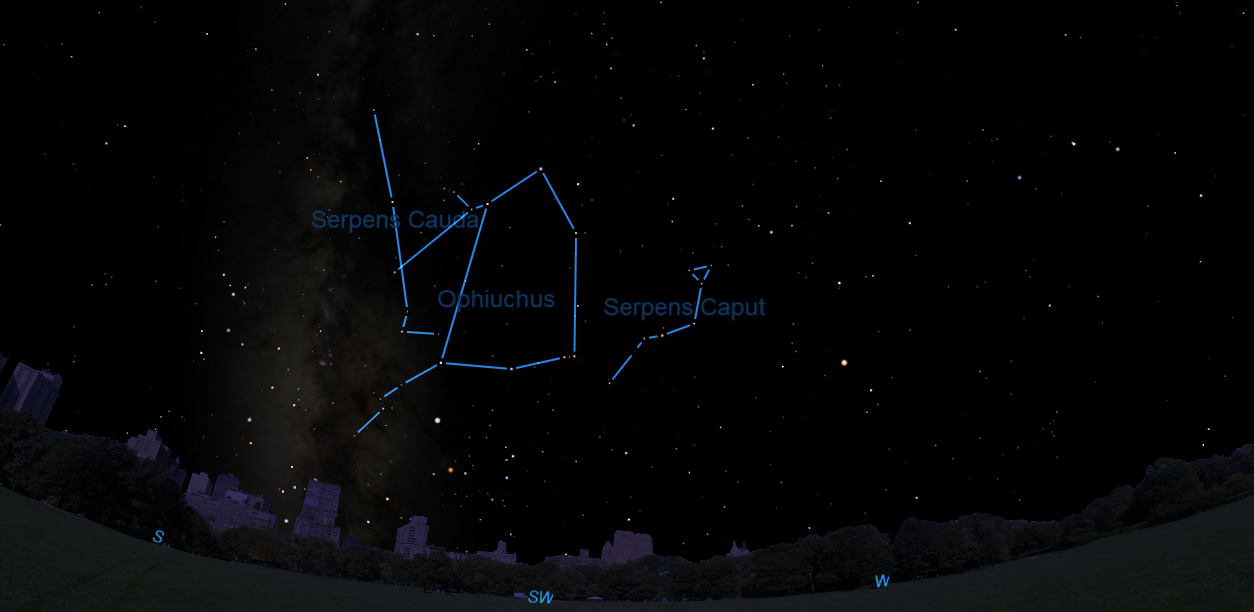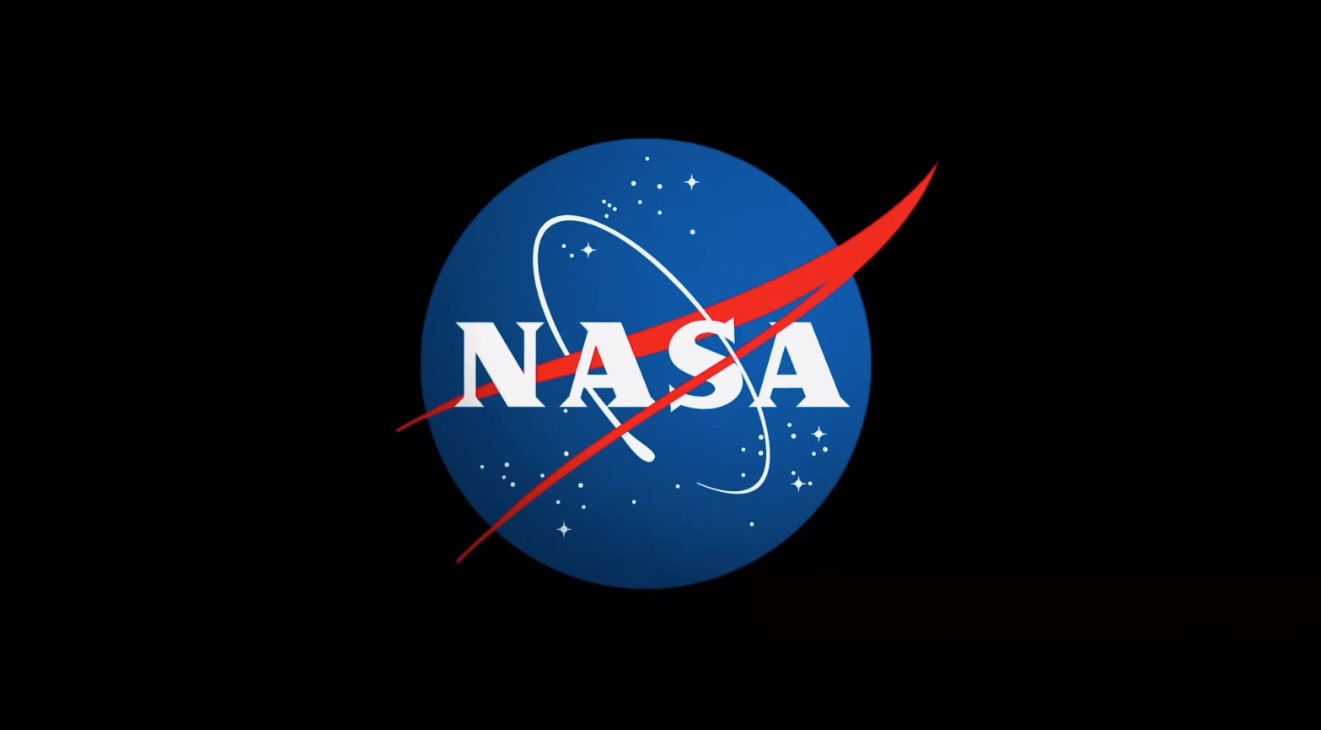How to See Ophiuchus and His Serpent in the Night Sky

Here's a pair of constellations that easily slithers out of the grasp of a beginning skywatcher: Ophiuchus, the serpent-bearer, and his snake.
As night falls this week, look toward the south-southwest and you will find, covering a large expanse of the sky, the "celestial medicine man" Ophiuchus, the serpent-bearer, a star pattern that teams with the constellation Serpens.
King James I of England, who reigned in the 1600s, once referred to Ophiuchus as "a mediciner, after made a god," because the serpent-bearer was often identified with Aesculapius, who, in Greek mythology, was a mortal physician who never lost a patient by death.
Related: Best Night Sky Events of August 2019 (Stargazing Maps)
The Orion soap opera
Aesculapius played a key role in the legend of Orion, the hunter. Orion was said to be a braggart who loved to boast that there was no animal on Earth that could defeat him, no matter how strong or ferocious the beast was. For some reason, this angered the goddess Hera, the wife of Zeus, who devised a plan to kill Orion by having a scorpion sting the great warrior in his heel, the little creature fatally wounding him with its poison.
The story could have ended there, but that was when Aesculapius was called to the scene, carrying with him a serpent, which had long been regarded as a source of healing.
Lo and behold! He brought Orion back to life.
Breaking space news, the latest updates on rocket launches, skywatching events and more!
This alarmed Hades, god of the dead, who became concerned that his kingdom was in jeopardy; what would happen if Aesculapius told his secret to other doctors? This would cheat this god of the underworld of some of his anticipated "guests." So, he prevailed upon his brother Zeus to liquidate both Orion and Aesculapius with a thunderbolt.
Thereafter, everybody concerned moved into the night sky: Orion, with his two faithful canine companions, Canis Major and Canis Minor; Aesculapius, with Serpens, the serpent; Scorpius, the scorpion; and Lepus, the hare, whom Orion was hunting when he had his encounter with the scorpion.
As a precaution, Orion and the scorpion took places on opposite sides of the sky, so they could never have a second encounter. Orion is a prominent winter constellation, while Scorpius is on display during the summer.
One thing that this story never explained was how Aesculapius' serpent grew so big; in the stars, holding the creature seems to require all of the doctor's strength!
Double identity and different monikers
The Hippocratic oath — named after the ancient Greek physician Hippocrates (460-377 B.C.), who is often regarded as the father of medicine — begins, "I swear by Apollo Physician and Aesculapius and Hygeia and Panacea and all the gods and goddesses, making them my witness, that I will fulfill according to my ability and judgement this oath and covenant."
Aesculapius was honored with a place in the night sky. Hygeia and Panacea, his daughters, are not represented in the sky, but both have long been patron saints to modern-day physicians
But why does our celestial medicine man go by a completely different (and odd) name, Ophiuchus? It is derived from the Greek roots "ophis" ("serpent") and "cheiro-o" ("to handle"). And so it is that Ophiuchus holds the serpent, which is still the symbol of the medical profession, as seen in the caduceus insignia of a snake coiled around a rod.
Getting acquainted with Ophiuchus and his snake
To trace this vast and somewhat-complex star pattern, start with a bright, second-magnitude star at the top of Ophiuchus' triangular head, known as "Rasalhague," derived from the Arabic for "the head of the serpent collector." I have always thought Ophiuchus resembled a barn silo.
Most neophytes have a tough time tracing this giant figure, but you should become familiar with the stars and star shapes surrounding Ophiuchus, such as the summer triangle, composed of the stars Vega, Deneb and Altair and located to the north and east; Hercules, which is immediately to the north; and Scorpius, with its ruddy star, Antares, which lies to the south. Once you do that, visualizing the serpent holder becomes somewhat easier.
As for Serpens, the snake (or serpent), it's the only constellation that is cut into two pieces: The head of the Serpent lies west of Ophiuchus and is known as Serpens Caput, while to the east of Ophiuchus lies smaller Serpens Cauda, the tail.
To the naked eye, four stars brighter than magnitude 4.5 mark the head of Serpens. The three brightest — Beta, Gamma and Kappa Serpentis — are set in a nearly equilateral triangle.
Off to the south is Messier 5, one of the finest globular clusters. Believed to contain over a half-million stars, M5 can be seen without optical aid, appearing as a fuzzy "star" on a very dark, clear night. Small binoculars show a tiny fuzzball. Giant binoculars (10 x 70s and up) show the cluster rapidly brightening toward the center, with perhaps the slightest hint of a mottled texture.
The (uncredited) 13th zodiacal sign
A final note about Ophiuchus: The ecliptic, that line in the sky that marks the path of the sun, moon and planets, passes right through the legs of this constellation. From Nov. 30 to Dec. 18, the sun resides within the boundaries of the serpent holder. So, he should be considered a member of the zodiac.
And yet, if that were the case, the zodiac would have 13 signs, not the currently recognized 12. In tracking the sun's whereabouts around the circle of the sky (360 degrees), ancient astrologers preferred 12 signs, each measuring 30 degrees in length. Of course, in astronomy, the official boundaries of the constellations are of different sizes. Some, like Virgo, are immense. Others, like Aries, are relatively small.
And including Ophiuchus in the zodiac simply wouldn't work for astrologers, even though the ecliptic crosses this constellation. Instead of a nice, neat 30 degrees assigned to each zodiacal sign, each would cover 27.692 degrees.
To the south of Ophiuchus lies Scorpius, the scorpion, a far brighter and more notable star pattern compared to the large, complex and much fainter serpent holder. So, even though the sun spends less time within the boundaries of the scorpion compared to our celestial snake charmer, Ophiuchus must defer its membership among the zodiacal signs to Scorpius.
Unfair, but sometimes, that's the way it goes. If he were still alive, Aesculapius would probably throw a hissy fit.
- The Brightest Visible Planets in August's Night Sky: How to See Them (and When)
- See the Elusive Planet Mercury in the Dawn Sky This August
- Catch a Shooting Star with 2019's Summer Meteor Showers
Joe Rao serves as an instructor and guest lecturer at New York's Hayden Planetarium. He writes about astronomy for Natural History magazine, the Farmers' Almanac and other publications, and he is also an on-camera meteorologist for Verizon FiOS1 News in New York's lower Hudson Valley. Follow us on Twitter @Spacedotcom and on Facebook.

Joe Rao is Space.com's skywatching columnist, as well as a veteran meteorologist and eclipse chaser who also serves as an instructor and guest lecturer at New York's Hayden Planetarium. He writes about astronomy for Natural History magazine, Sky & Telescope and other publications. Joe is an 8-time Emmy-nominated meteorologist who served the Putnam Valley region of New York for over 21 years. You can find him on Twitter and YouTube tracking lunar and solar eclipses, meteor showers and more. To find out Joe's latest project, visit him on Twitter.
